When winter arrives, many people feel the weight of shorter days and colder weather. The lack of sunlight can make homes feel dull, affecting how we feel daily. But what if small changes in your space could make a big difference?
Inspired by the feel-good power of vibrant colors, a new design trend blends science and style. Research by neurobiologists shows that beauty—like bold patterns and warm hues—triggers positive reactions in the brain. This approach turns living spaces into mood-boosting retreats.
Take Ingrid Fetell Lee’s famous yellow chair experiment. A single bright piece transformed not just a room but also the energy of those who used it. Your surroundings play a key role in daily happiness, and it’s easier to refresh them than you think.
Key Takeaways
- Seasonal mood shifts are common but manageable with the right changes.
- Colorful, lively spaces can influence emotions positively.
- Science supports the link between vibrant design and well-being.
- Small updates, like a bold furniture piece, make a big impact.
- Your home can be a daily source of energy and joy.
What Is Dopamine Decor?
From fashion runways to living rooms, bold aesthetics are making waves in unexpected ways. This movement, often called dopamine decor, turns homes into vibrant spaces that spark joy. Unlike rigid design rules, it celebrates individuality and energy.
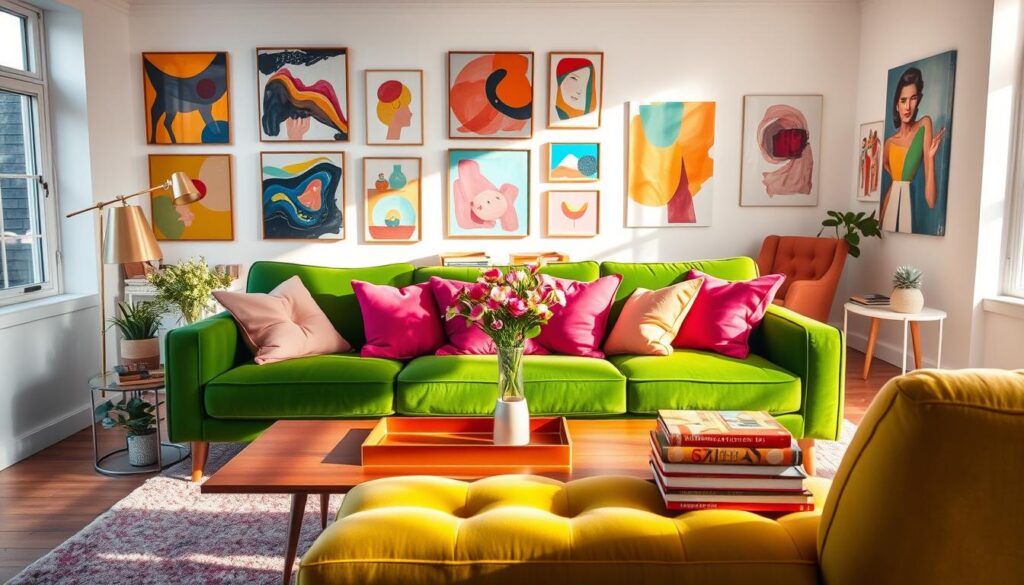
The Origins of the Trend
It started with “dopamine dressing”—a 2022 fashion trend where outfits boosted mood through color. Soon, TikTok creators adapted the idea for homes. Videos of Albert+Ingrid’s rainbow makeovers went viral, proving gray neutrals weren’t the only option.
Designers like Lisa Gilmore championed the “collected look,” mixing textures and eras. Meanwhile, Sasha Malchi showed how pattern-clashing bars could feel cohesive. The trend democratized design, making psychology-backed upgrades accessible to renters and owners alike.
How It Differs from Minimalism
While Marie Kondo’s minimalism focuses on less, dopamine decor embraces more—thoughtfully. Arterberry Cooke wallpapers layer botanicals with geometrics, and Reena Sotropa’s coral accent walls prove bold doesn’t mean chaotic.
This style isn’t about clutter. It’s curating pieces that tell your story, like a boho wall hanging or a thrifted lamp. The goal? Spaces that feel alive, not sterile.
The Science Behind Dopamine Decor for Mental Health
Bright hues and dynamic patterns do more than please the eye—they activate our neural pathways. Research shows that our surroundings directly influence the brain’s chemical responses, creating a ripple effect on emotions.
How a Key Neurotransmitter Shapes Mood
Often called the “reward molecule,” dopamine helps form positive habits—like craving sunlight or enjoying art. Unlike addiction, which floods the system, small, frequent boosts from vibrant spaces sustain motivation. Studies by Zeki and Ishizu found that viewing beautiful art triggers dopamine release, similar to eating chocolate.

This neurotransmitter isn’t alone. Serotonin (calmness) and oxytocin (connection) work alongside it. Sampedro-Piquero’s research on enriched environments proves varied textures and hues create lasting emotional resilience.
Why Color and Pattern Matter
Warm tones like coral or saffron increase excitement, per Yildirim’s 2011 study. Conversely, cool blues promote focus. Patterns also play a role—complex designs engage the brain more than flat surfaces, as seen in Crossmodal Lab’s multi-sensory experiments.
| Color Type | Effect | Best For |
|---|---|---|
| Warm (reds, yellows) | Boosts energy | Living rooms, kitchens |
| Cool (blues, greens) | Enhances calm | Bedrooms, offices |
| High-contrast patterns | Stimulates focus | Creative spaces |
Sebastian Bergström’s saturated color experiments show even one bold wall can combat seasonal dullness. Like tiny celebrations, these “hits of pleasure” add up, turning homes into daily sanctuaries.
Why Seasonal Depression Calls for Joyful Spaces
Winter’s shorter days don’t just dim the sky—they dim spirits too. For 5% of U.S. adults, seasonal affective disorder (SAD) turns colder months into a battle with fatigue and low mood. But your environment can be a powerful ally—if you design it right.

The Link Between Light and Mood
Sunlight fuels our circadian rhythms. In winter, reduced exposure disrupts sleep and serotonin levels. Rachel Smith, an interior designer, countered this by installing a pink LED ceiling. “It mimics dawn,” she says, “tricking the brain into feeling energized.”
Studies back this up:
- Light therapy boxes boost alertness by 67% (NIMH).
- Yildirim’s 2011 research shows warm hues increase dopamine gently, unlike harsh white light.
How Your Environment Affects Winter Blues
Dark walls and heavy drapes invite “visual hibernation,” worsening SAD symptoms. Instead, Hulala Home suggests jewel tones—emerald throw pillows or amethyst curtains—to reflect scarce sunlight.
Space-saving tricks:
- Swap blackout blinds for sheer ones.
- Place mirrors opposite windows to double natural light.
- Use metallic accents to catch and scatter rays.
“Your home should be a mood thermostat—adjustable for seasonal needs.”
Key Elements of Dopamine Decor
Color has the power to transform a room—and your mood—in seconds. The right hues, patterns, and textures turn blank walls into energy boosters. Here’s how to layer them for maximum joy.
Bright Colors That Spark Joy
Warm reds and yellows spark excitement, while blues soothe. Benjamin Moore’s *Hot Lips 2003-20* is a fiery pick for accent walls. Hulala Home’s fuschia velvet loveseat proves bold colors demand attention.
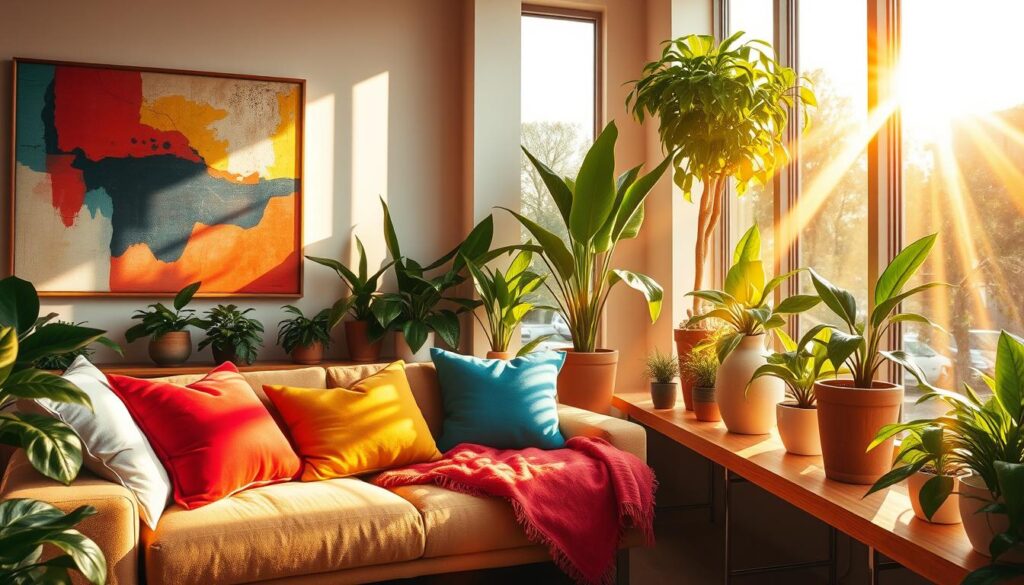
- Pair complements (orange + blue) for balance.
- Try IKEA’s *Halved* rug for color-blocking.
- Avoid flat neutrals—they absorb light.
Bold Patterns and Textures
Mix stripes with florals, like *Kate Anlyan’s* 70s-inspired bars. Tactile textures add depth:
- Velvet pillows feel luxurious.
- Bouclé throws add cozy contrast.
- Rattan chairs bring organic warmth.
*Josh+Matt Design* keeps walls light but layers vibrant decor. “Patterns should dance, not clash,” they advise.
Personalized Touches That Matter
Gallery walls with race medals or travel photos boost connection. *Amelia Stanwix* balances maximalism by grouping meaningful items:
- DIY upholstery projects (try thrifted chairs).
- Storage ottomans hide clutter while adding color.
- Avoid joyless trend chasing—edit ruthlessly.
“Your home should tell your story, not Pinterest’s.”
How to Start with Dopamine Decor
Transforming your space doesn’t require a full overhaul—small tweaks can spark big joy. Whether you’re renting or own, these low-commitment ideas help you test the waters without overwhelm.
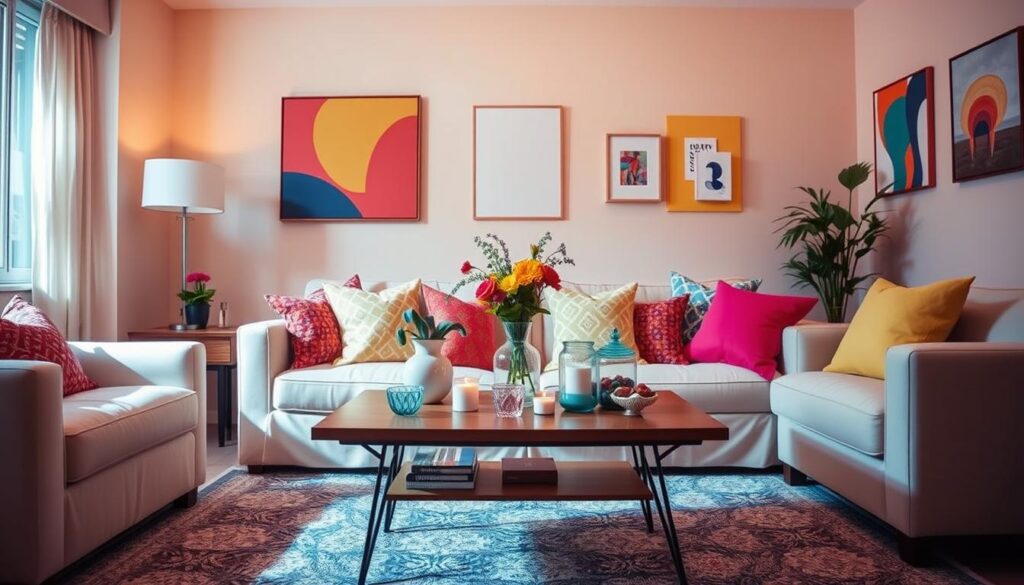
Small Changes, Big Impact
Begin with peel-and-stick wallpaper. Brands like *Tempaper* offer bold prints for accent walls—no glue or long-term commitment. RJ Living suggests pairing it with vibrant throw pillows for instant energy.
Thrifted furniture makeovers are another fun way to experiment. A $20 side table painted in *Pantone’s* 2024 Peach Fuzz becomes a statement piece. Rachel Mae Smith’s ceiling paint hack proves even overhead spaces matter: “A soft pink or sky blue adds warmth without dominating the room.”
Choosing Your Joyful Palette
Test paint samples before committing. Hulala Home delivers sample pots in 48 hours, so you can see how light changes colors throughout the day. Journal your reactions—do mustard yellows energize or irritate you?
For a balanced look, try color blocking. Paint half a wall in *Benjamin Moore’s* Hot Lips and pair it with neutral furniture. Bree Steele advises: “Add one bold item per room first. Build gradually to avoid impulse buys.”
- Swap dark curtains for sheer ones to amplify light.
- Use Buy Nothing groups to find pieces like Norden’s gateleg table.
- Metallic accents (gold frames, copper vases) catch and scatter light.
Room-by-Room Dopamine Decor Tips
Every room in your home can become a source of daily joy with the right touches. Whether it’s a cozy reading nook or a lively kitchen, intentional design turns functional spaces into mood-boosting havens. Here’s how to tailor each area to spark happiness.
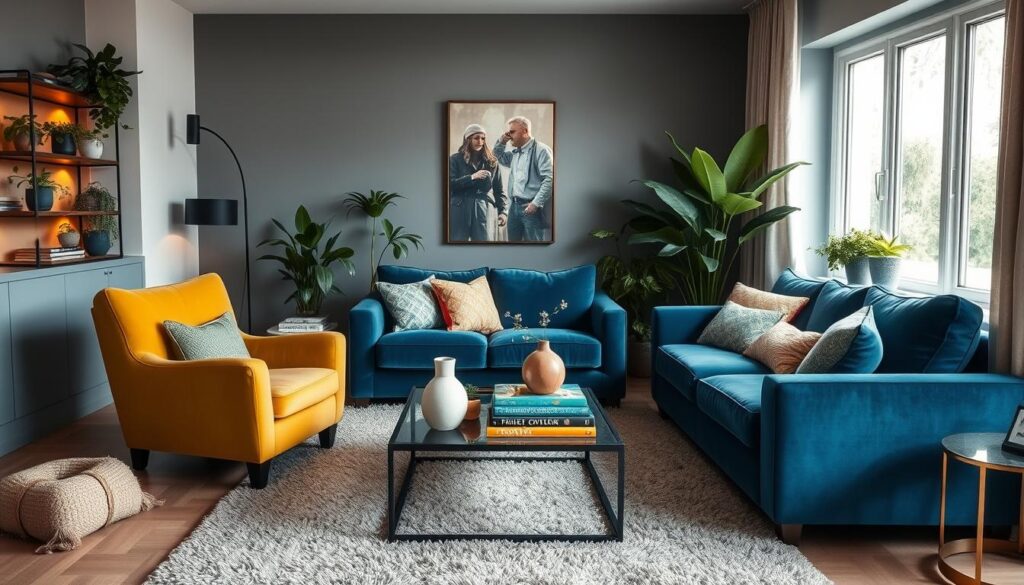
Living Room: Vibrant and Inviting
This space sets the tone for gatherings. Layer patterned rugs over hardwood floors for warmth, and mix textiles like velvet cushions with linen throws. *The Collective’s* whimsical wallpapers add playful energy behind shelves.
- Use multifunctional gateleg tables for flexible seating.
- Add a bold art piece as a conversation starter.
- Rotate decor seasonally to keep the room fresh.
Bedroom: Cozy Yet Stimulating
Balance stimulation and sleep needs with warm-toned bedding and blackout curtains. A peach accent wall (like *Pantone’s 2024 pick*) feels uplifting without overwhelming.
“Your bedroom should recharge you—choose colors that whisper, not shout.”
Home Office: Productivity Meets Pleasure
Zone your area with color: a teal desk for focus, yellow shelves for creativity. *Jenny Johnston’s* ruby red laundry room proves even utility spaces deserve boldness.
- Try peel-and-stick wallpaper for temporary vibrancy.
- Incorporate a small indoor plant for natural energy.
- Keep cords hidden to maintain visual calm.
From entryway color pops to garage pegboards painted sunshine yellow, no room is too small for joy. Start with one change and let the happiness spread.
Color Psychology in Dopamine Decor
Colors speak louder than words—especially in your home. They shape moods, spark energy, and even influence habits. Understanding how hues work helps you craft spaces that feel as good as they look.
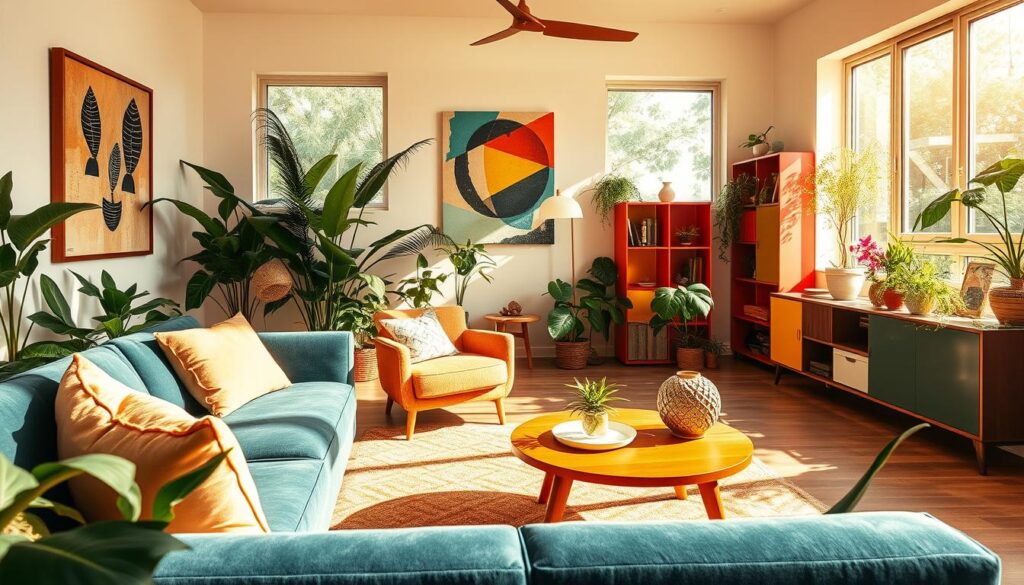
Warm vs. Cool Tones
Warm tones like reds and yellows excite the senses. Benjamin Moore’s *Hot Lips 2003-20* adds instant energy to kitchens. Cool blues and sage greens soothe, perfect for bedrooms.
Cultural associations matter too. In Japan, red signifies luck, while Scandinavians favor airy whites. Adapt your palette to seasonal light—deep emeralds in winter, citrus tones in summer.
| Color Type | Effect | Best Use |
|---|---|---|
| Warm (oranges, pinks) | Boosts social energy | Dining rooms |
| Cool (blues, lavenders) | Promotes relaxation | Bedrooms |
| Neutrals (beiges, taupes) | Balances bold accents | Foundational walls |
Unexpected Color Combinations
Pantone’s *Viva Magenta 18-1750* pairs surprisingly well with mint. Yasu Home’s checkered rug and stripe pillow combo proves clashing colors can work. Follow the 60-30-10 rule: 60% dominant hue, 30% secondary, 10% accent.
Test swatches in different lights. *Sherwin-Williams’* Emerald UX finish shifts from jewel-toned to muted under lamplight. For subtle boldness, try Farrow & Ball’s *Dead Salmon*—a pink-beige that glows at dusk.
“Rules are made to be broken. If lime green makes you happy, paint the ceiling with it.”
Maximalism vs. Minimalism: Finding Your Balance
Finding harmony between bold and simple styles can transform your home. It’s not about choosing one over the other—it’s blending them in a way that feels right for you.
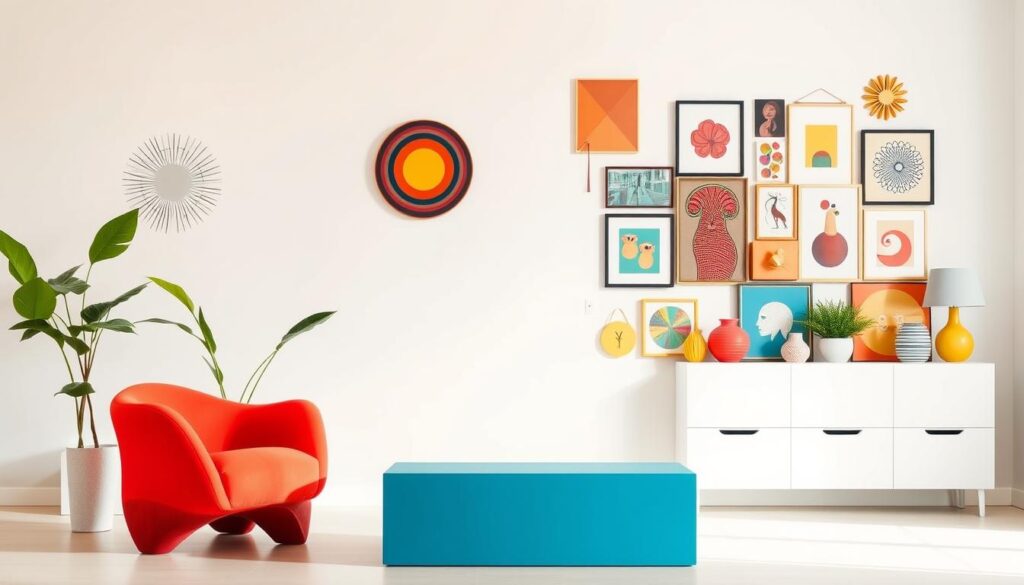
When More Is More
Conscious maximalism, as defined by Arterberry Cooke, means curating vibrant pieces with purpose. Unlike cluttercore, it uses saturated neutrals to ground bold accents. Think jewel-toned velvet sofas paired with earthy ceramics.
Compare this to Scandinavian minimalism, where clean lines dominate. Both styles work—the key is visual weight distribution. Reena Sotropa’s balanced accent walls show how one bold feature can anchor a room without overwhelm.
How to Avoid Overwhelm
Negative space is your ally. In Detail Interiors suggests treating empty areas as design elements. For example, leave 30% of shelves bare to let displayed items shine.
| Technique | Maximalism | Minimalism |
|---|---|---|
| Texture Contrast | Mix velvet, rattan, and metallics | Stick to 2–3 materials |
| Storage Solutions | Open shelving with curated items | Hidden compartments |
| Color Palette | 5+ colors with a unifying tone | Monochromatic + one accent |
Rotate decor seasonally to keep your sense of joy fresh. Swap summer’s bright throw pillows for winter’s rich wool blankets. This aligns with neuroaesthetic principles—our brains crave novelty.
“Maximalism isn’t about filling every inch. It’s about choosing pieces that tell your story.”
Follow these trends mindfully, and your home will feel both lively and serene.
DIY Dopamine Decor Projects
Breathing new life into old pieces is a creative way to boost happiness at home. Whether you’re upcycling thrifted furniture or crafting a gallery wall, these projects add personality without breaking the bank.
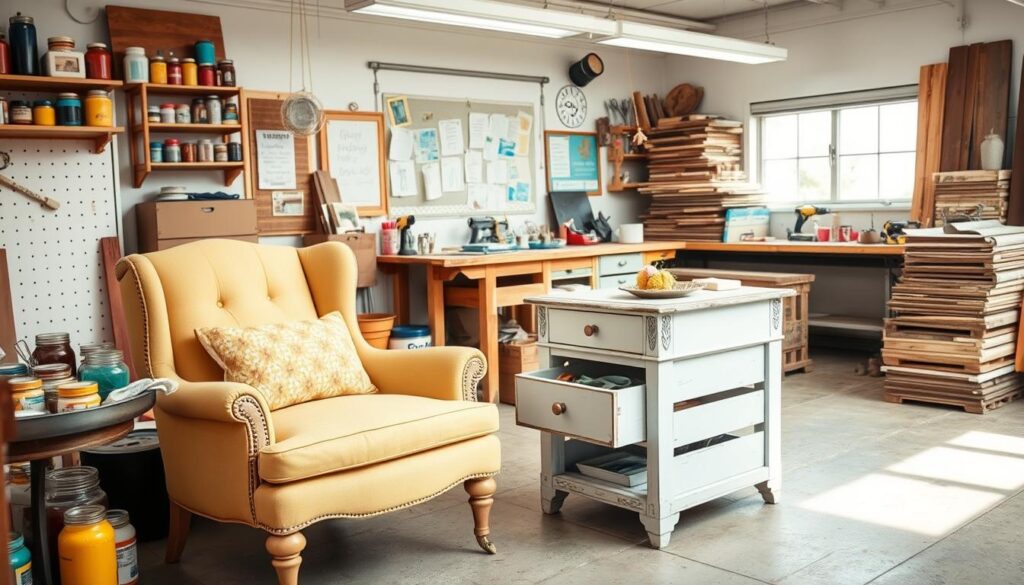
Upcycling Furniture for Joy
Chalk paint transforms dull dressers into statement pieces. Try Annie Sloan’s vintage hues for a distressed look. Habitat for Humanity Restores often hide gems—like a $20 side table perfect for a neon makeover.
For renters, temporary upgrades work wonders:
- Washi tape adds patterns to drawers without damage.
- E6000 adhesive jazzes up thrifted frames with seashells or beads.
- IKEA hack communities share clever ideas, like turning a Billy bookcase into a retro bar.
Creating a Gallery Wall That Inspires
Mix family photos with art prints for a layered effect. Persnickety Box prints high-quality photos in custom sizes. Hulala Home’s assembly tips ensure frames hang straight—no frustration.
Pro tips for cohesion:
- Stick to a color palette (e.g., black-and-white with gold accents).
- Use A’Driane Nievis abstracts for bold focal points.
- Pinterest boards help visualize layouts before hammering.
“Avoid permanent alterations. Joy evolves—let your space adapt with you.”
These projects prove small changes make a big impact. Start with one, and let the joy spread.
Lighting: The Unsung Hero of Dopamine Decor
Good lighting transforms a space from dull to dynamic. It sets the mood, enhances colors, and even affects energy levels. Whether natural or artificial, the right lighting can make your environment feel alive.
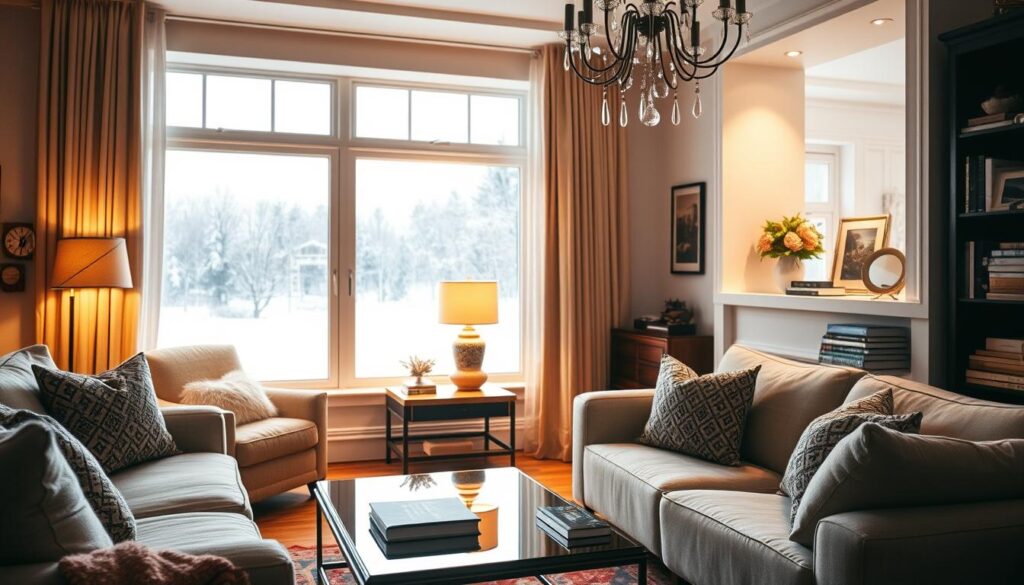
Natural Light vs. Artificial Light
Sunlight is the gold standard for brightening a room. It boosts serotonin and regulates circadian rhythms. But when natural light is scarce, smart artificial solutions step in.
Consider these tips:
- Use UV-filtering window films to protect furniture while maximizing sunlight.
- Place mirrors opposite windows to double natural light exposure.
- Choose sheer curtains instead of heavy drapes for daytime brightness.
Choosing the Right Lamps and Bulbs
Not all bulbs are created equal. Kelvin temperature determines warmth or coolness:
| Kelvin Range | Effect | Best For |
|---|---|---|
| 2000K–3000K | Warm, cozy glow | Bedrooms, living rooms |
| 3100K–4500K | Neutral, balanced | Kitchens, home offices |
| 4600K–6500K | Cool, energizing | Task lighting, garages |
For statement pieces, the Lersta floor lamp offers affordability and style. Smart bulbs let you program color temperatures throughout the day—warm at night, cool in the morning.
“Lighting is like jewelry for your home—it should complement, not overpower.”
Avoid blue light overload in evenings with amber-toned bulbs. Dimmer switches add flexibility, while SAD lamps combat seasonal blues with 10,000 lux brightness.
Incorporating Nature into Your Space
Nature has a way of making spaces feel alive and welcoming. From air-purifying plants to woven rattan accents, these elements bring warmth and vitality indoors. Even small touches, like a spider plant on a shelf, can uplift your daily mood.
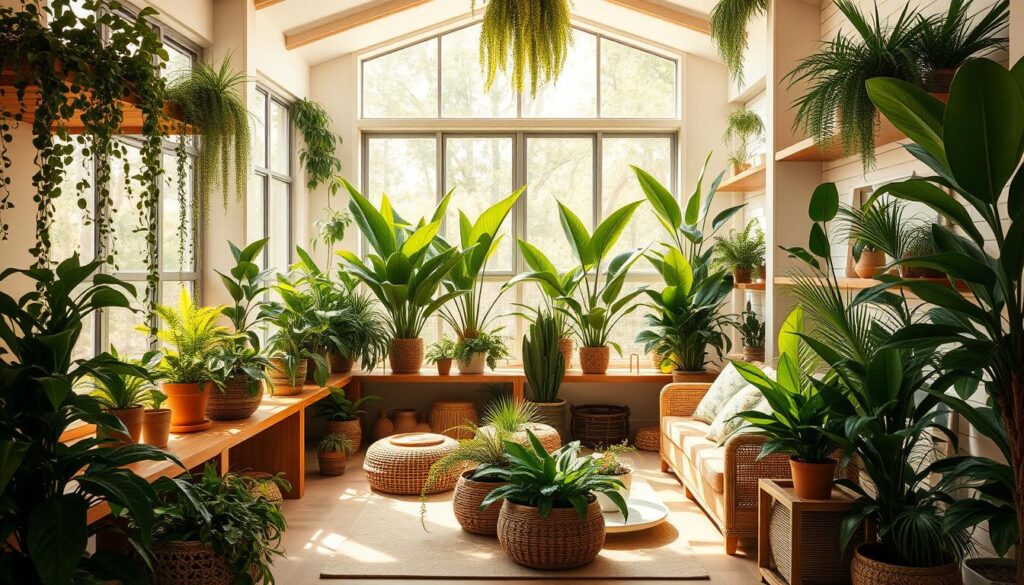
The Benefits of Indoor Plants
NASA’s Clean Air Study highlights how certain *greens* filter toxins. Snake plants and peace lilies remove formaldehyde, while Boston ferns add a lush touch. For pet owners, *The Sill* offers non-toxic options like calatheas.
Bioactive terrariums are trending—self-sustaining ecosystems in glass jars. They’re low-maintenance and visually striking. Rotate plants seasonally: succulents in summer, evergreen ferns in winter.
| Plant | Air-Purifying Benefit | Care Level |
|---|---|---|
| Spider Plant | Removes xylene | Easy |
| Bamboo Palm | Filters benzene | Moderate |
| English Ivy | Reduces mold | Easy |
Using Natural Materials for Warmth
Rattan and wicker are resurging—*natural materials* that add organic *textures*. Try a bamboo room divider or seagrass baskets for storage. Moss wall art, like *Modern Moss’s* vertical panels, brings the forest indoors.
For soundscapes, bamboo acoustic panels dampen noise while adding visual interest. Pair them with a small tabletop fountain for a serene corner. As *Real Simple* notes:
“Nature-inspired design isn’t just aesthetic—it’s a mindset shift toward calm.”
Avoid overwatering with moisture meters, and opt for sustainable brands like *Terrain* for ethically sourced wood pieces. Your home will feel like a breath of fresh air.
Dopamine Decor on a Budget
Revamping your space doesn’t have to drain your wallet—joyful design thrives on creativity, not cash. With clever sourcing and DIY flair, you can curate a home that sparks happiness without overspending. Here’s how to make every dollar count.
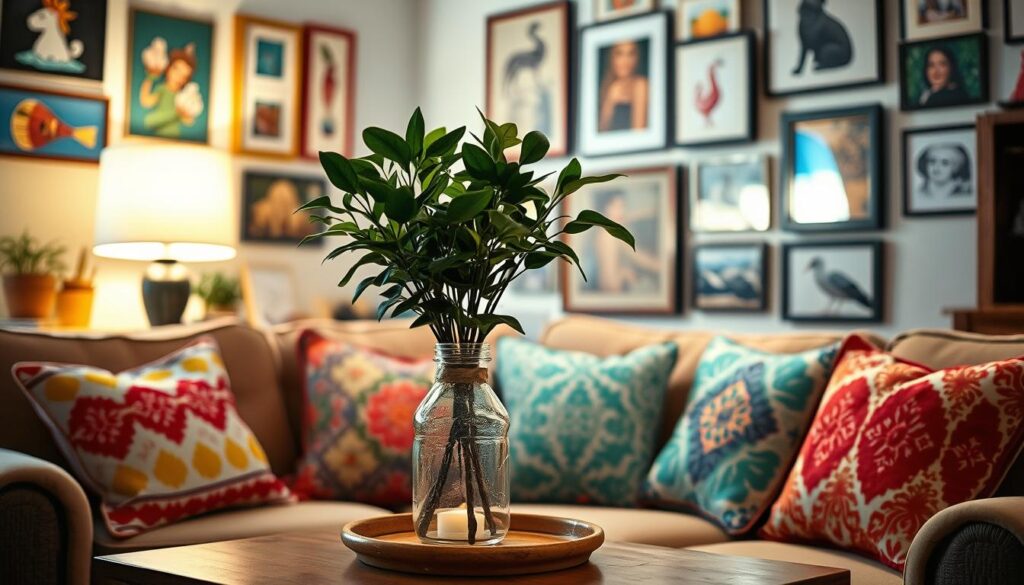
Thrift Store Finds That Bring Joy
Local thrift shops hide gems like vintage lamps or quirky frames. Map out routes using The Thrift Shopper app to target high-yield areas. Facebook Marketplace haggling works best mid-month when sellers need quick sales.
Buy Nothing Groups are goldmines for free decor. One member scored a mid-century chair worth $300 just by asking. For rentals, washi tape adds patterns to walls without damage—perfect for temporary vibrancy.
Affordable Art and Accessories
Society6 artists offer prints under $30, while DIY abstract painting with acrylics costs even less. Frame digital downloads with IKEA’s Ribba series for a polished look. Target’s Opalhouse line delivers Anthropologie-esque rugs at half the price.
- Host swap parties to refresh decor for free.
- Follow @AnthropologieDupes for budget lookalikes.
- Avoid fast furniture—opt for solid wood thrifted pieces.
“Your home’s personality isn’t tied to price tags. A $5 vase with wildflowers can outshine a $500 sculpture.”
From peel-and-stick wallpaper to spray-painted thrift flips, small budget tweaks yield big joy. Start with one project and let the happiness multiply.
Seasonal Adjustments for Year-Round Joy
Your space should evolve with the calendar, reflecting nature’s rhythm and cultural celebrations. Small updates keep your home feeling fresh and aligned with the weather outside. Here’s how to adapt your surroundings without a full redesign.

Swapping Decor with the Seasons
H&M Home’s seasonal textile lines make it easy to rotate looks. Lightweight linen duvet covers work for summer, while flannel sheets add winter warmth. The Container Store’s modular bins simplify storing off-season items.
Follow this rotation schedule to stay organized:
| Season | Key Swaps | Storage Tip |
|---|---|---|
| Spring | Pastel throw pillows, sheer curtains | Vacuum-seal winter blankets |
| Summer | Cotton rugs, tropical prints | Label bins by room |
| Fall | Wool throws, pumpkin accents | Use silica gel packs to prevent mold |
| Winter | Faux fur, metallic lanterns | Store in climate-controlled areas |
Pantone’s seasonal forecasts inspire color palettes. 2024’s Peach Fuzz pairs well with spring florals, while deep Rust complements autumn leaves. Nature tables—with pinecones or seashells—bring the outdoors in.
Holiday-Themed Dopamine Boosts
Holidays offer chances to experiment. Crate & Barrel’s collabs provide elegant ornaments, but DIY alternatives like salt-dough shapes add personality. For Easter, try dyeing napkins with beet juice for vibrant place settings.
Cultural elements enrich celebrations:
- Diwali: String LED tea lights for a safe glow.
- Hanukkah: Blue-and-white woven trays hold gelt.
- Christmas: Repurpose scarves as tree skirts.
“Mother’s Day brunches shine with fresh tulips and mismatched vintage plates—joy thrives in imperfection.”
Weather-responsive textiles, like moisture-wicking cushions for summer, ensure comfort year-round. The key? Edit ruthlessly—store what sparks joy, donate the rest.
Real-Life Dopamine Decor Success Stories
Seeing is believing—these real home transformations prove vibrant spaces uplift daily life. Beyond theory, they showcase how color and texture shifts create tangible joy. Let’s explore the before and after magic.
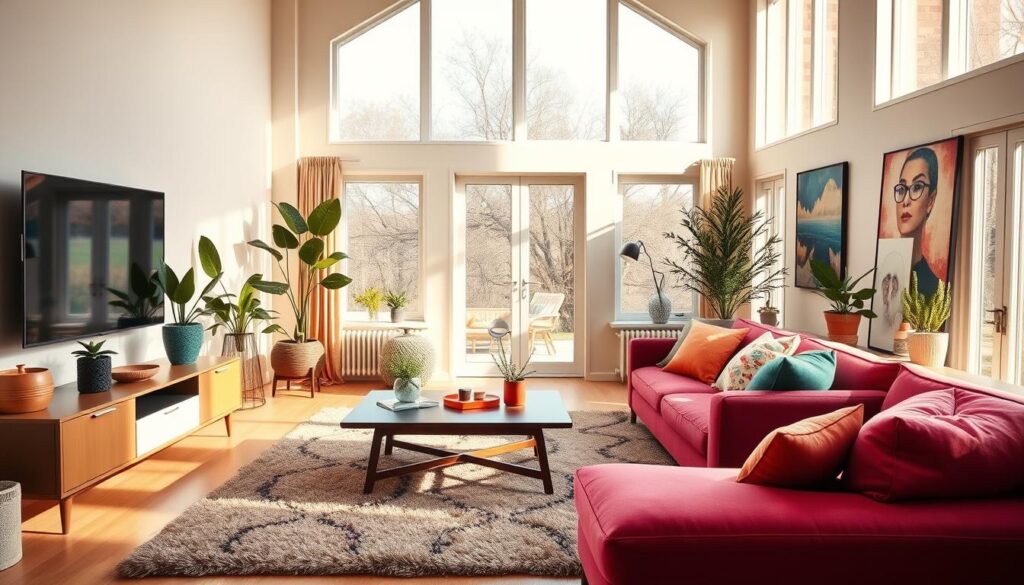
From Dull to Dynamic: Color Makeovers
Jenny Johnston’s once-beige laundry room became a ruby-red retreat. “I dreaded folding clothes here,” she admits. After painting cabinets in Benjamin Moore’s Caliente, she noticed:
- 20% faster chore completion (self-timed)
- Family members lingering to chat
- Guests complimenting the “happy vibe”
Rachel Smith’s sitting area gained new life with a peach ceiling and striped rug. Her testimonial explains: “The space now pulls me in instead of feeling like a waiting room.”
Voices of Transformation
Apartment Therapy’s 2023 contest revealed how design solves real challenges:
| Challenge | Solution | Result |
|---|---|---|
| ADHD focus | Turquoise office wall + timer | Task completion ↑ 40% |
| Chronic pain | Adjustable-height violet desk | Discomfort ↓ during work |
| Rental limits | Removable wallpaper + LED strips | Landlord-approved joy |
“My empty nest felt cavernous until Hulala Home’s rainbow bookshelves gave it purpose again.”
These success stories aren’t flukes—they’re repeatable. Whether tackling a single wall or whole room, the before and after difference speaks volumes.
Common Mistakes to Avoid
The path to a happy home isn’t just about adding—it’s about smart editing. Even vibrant spaces can feel chaotic if basic design principles are overlooked. Let’s explore how to dodge these pitfalls while keeping your space joyful and practical.
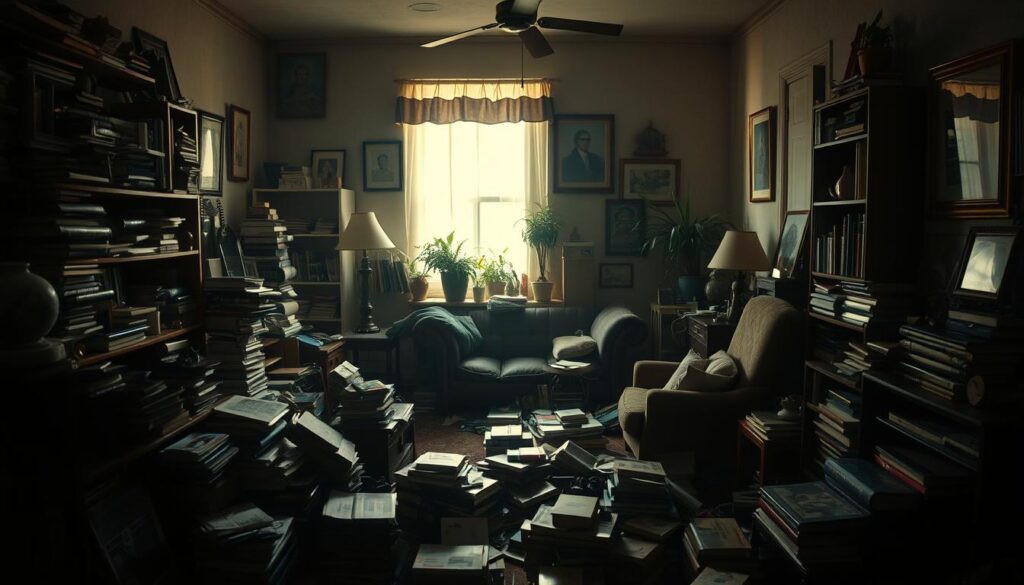
Overcrowding Your Space
More isn’t always merrier. Arterberry Cooke’s research shows rooms need 30% negative space to let focal points shine. Visual clutter increases stress hormones by 15%, per Cornell’s environmental psychology lab.
Spot these warning signs:
- Walkways narrower than 36 inches
- Furniture touching multiple walls
- Collections displayed without grouping
| Feng Shui Conflict | Solution |
|---|---|
| Too many door obstructions | Keep pathways clear |
| Overloaded shelves | Use the 50/50 display rule |
| Cluttered entryways | Add multi-functional storage |
Ignoring Functionality for Aesthetics
RJ Living’s 2023 survey found 43% regret buying pretty but uncomfortable furniture. Always test pieces for daily use—a velvet sofa might look great but stain easily.
Ergonomic essentials checklist:
- Chair seat height: 16-21 inches
- Coffee table 18 inches from sofa
- Outlet access within 3 feet of workspaces
“Trends fade, but injuries from poor layouts linger. Always measure twice before arranging.”
Safety matters too. Keep flammable textiles 3 feet from heaters, and choose rounded furniture edges if kids or pets are present. Your space should spark joy—not hazards.
Conclusion
Joyful surroundings aren’t just pretty—they’re powerful mood boosters. Science shows vibrant colors and textures spark positive brain responses, turning homes into sanctuaries. Start small: a bold pillow or sunny artwork can shift energy instantly.
Your space should reflect you. Experiment with hues that make you feel good, whether it’s a mustard armchair or a teal bookshelf. Hulala Home’s workshops offer easy DIY tricks, or browse Pinterest for playful inspo.
Seasonal blues fade when your environment works with you. Let light in, layer textures, and celebrate what makes you smile. As designer Ingrid Fetell Lee says: “Joy isn’t frivolous—it’s fuel.” Ready to transform? Share your #HappySpace with us!

